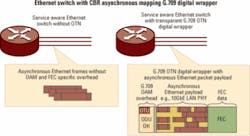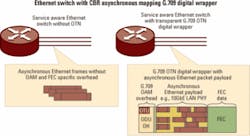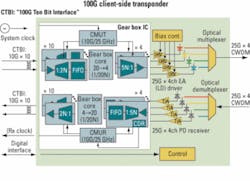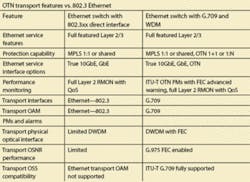by Siraj Nour El-Ahmadi
Since its beginnings as a best-effort LAN protocol in 1973, Ethernet continues its ascension unabated as a widely deployed, simple to use, and yet cost-effective technology. Having totally consumed data and telecommunications interfaces at the enterprise, Ethernet is fast reaffirming itself in the access, metro, and wide-area networks as well, thus bringing the same disruptive economics and value proposition to the core network. Growing at 30 to 50% per year, Ethernet services are set to reach $31 billion in 2012, according to Vertical Systems.
Today, virtually all IP traffic is carried over Ethernet, and carriers and multiservice operators (MSOs) have capped their investment in legacy ATM and Frame Relay networks. In fact, Ethernet is fast becoming the transport technology of choice, and enterprise customers are demanding Ethernet transport services in lieu of the traditional TDM DS-n or OC-n circuits. For most carriers, indeed, Ethernet is not only a key service but also a strategic infrastructure technology upon which to build a simpler network and offer flexible, high-growth value-added services.
Switch/routers have evolved to meet the implications of this trend, adding
features that enable them to perform such functions as aggregation, restoration, and protection switching. However, until recently they have not been able to handle the final requirement for efficient Ethernet transport: encapsulation into OTN G.709. New ASIC technology has created a generation of hot-pluggable DWDM transceivers that overcomes this final hurdle to efficient, Ethernet-based transport architectures.
Lacking true carrier transport operations, administration, maintenance, and provisioning (OAM&P) features such as section and path layer segmentation and bit-for-bit performance monitoring, carriers resorted to the existing SONET/SDH infrastructure to carry Ethernet traffic across the network. Generic Framing Procedure (GFP) and Link Access Procedure-SDH (LAP-S) were the two main protocols used to encapsulate the asynchronous Ethernet frames. Virtual Concatenation is then used to map the encapsulated Ethernet datagrams into fixed bit-rate SONET or SDH payloads. The ratification by IEEE of 10-Gigabit Ethernet (10GbE), however, proved to be an inflection point for the network. Neither SONET OC-192 nor SDH STM-64 payloads of 9.6 Gbits/sec are large enough to accommodate 10GbE bandwidth at 10.3 Gbits/sec.
The industry�s first attempt beyond GFP was to endow Ethernet with more OAM&P features such as those defined in IEEE 802.1ag and ITU-T Y.17 (connectivity fault management) and IEEE 802.3ah (Ethernet in the First Mile). While Ethernet OAM&P capacity at Layer 2 was indeed augmented, it did not offer carriers sufficient monitoring and alarming at the bit level to replace SONET/SDH. The focus quickly shifted to another Layer 1 transport network: ITU-T G.709 Optical Transport Network (OTN).
Not only does OTN offer enough payload bandwidth to accommodate 10GbE, it also is the only transport layer standard in the industry that can carry it transparently, including the proprietary overhead associated with some specific vendor implementations. G.709 defines a method of mapping a constant bit rate (CBR) signal, such as 10GbE LAN PHY, directly into a G.709 ODU/OTU frame for asynchronous payload transport.
As shown in Fig. 1, the asynchronous payload Ethernet traffic of the service-aware switch/router is transparently mapped into a G.709 frame with all the associated OTU/ODU overhead and forward error correction (FEC) for transport network OAM and performance. Since the G.709 CBR asynchronous Ethernet mapping is 100% transparent, compatibility between switches and routers is guaranteed. OTN also scales in bit rate to support the other various speeds of Fibre Channel and Ethernet and provides a robust management overhead analogous to SONET/SDH that ensures management of both the payload and service. It also offers a separate overhead for performance monitoring and fault signaling, as well as a general communications channel (GCC) for remote management, software downloads, and other control functions.A G.975 standardized FEC code within the G.709 frame provides a minimum of 6-dB optical signal-to-noise ration (OSNR) gain at a corrected bit error rate of 10�15, which is a considerable improvement in the network and enables further reach and flexibility. Additionally, the ability to count the number of corrected FEC errors gives the carrier the ability to warn of impending traffic disruption and take preventive maintenance action. The forward-and-backward looking nature of OTN standards and OTN�s ability to adapt to a multitude of synchronous and asynchronous payloads is driving its success and making it the industry de facto choice for a converged network.
The table on page 16 summarizes some of the key transport features of OTN when contrasted to 802.3 Ethernet.
Figure 2 illustrates a typical architecture of the Ethernet-focused transport network. The Ethernet/MPLS switch/router provides the majority of the carrier�s services such as VoIP, IPTV, VPLS, E-LAN, E-Line, etc. The switch/router is then interfaced through a short-reach interface to a transport platform that can either be a multiservice provisioning platform, an optical switch, or a DWDM transponder system depending on the amount of traffic that must be managed at the particular node. The three main functions provided by the transport platform are:
- Aggregating and grooming the various lower speeds from the client interfaces into a higher-speed interface to match that of the optical network for more efficient transport.
- 50-msec protection switching and restoration in the event of a failure.
- OTN G.709 encapsulation into DWDM for better utilization of the fiber plant and optical transport layer OAM&P.
The advent of high-density 10- and 40-Gbit/sec ports on the core switch/routers alleviates the need for the first transport platform function: aggregation. In fact, the switch/router offers more efficient aggregation and grooming, and hence lower overall network cost, thanks to statistical multiplexing as opposed to the static circuit multiplexing offered by the transport platform. Quality of service and delivery of the Ethernet service is achieved by the switch/router with existing Ethernet and IP Layer 2/3 mechanisms broadly deployed today. The switch/routers can also offer 50-msec restoration via MPLS fast reroute and do it in a meshed manner that is much more bandwidth efficient and less expensive than the traditional transport ring restoration mechanisms that must reserve 50% of the network bandwidth for restoration.
Today, only DWDM and OTN functionality, because of its complexity, size, and power at 10 Gbits/sec and higher, is keeping the transport platform from becoming an obsolete and unnecessary network element plaguing the network with its capital and operational costs and offering little or no revenue-generating services for the carrier or MSO. The Metro Ethernet Forum, in fact, demonstrated in a network study that native optical Ethernet can save as much as 49% in the network by eliminating the unnecessary SONET/SDH transport platforms.
Due to limited real estate on the line cards and the need for high port density, switch/routers predominantly use pluggable optical transceivers such as XENPAK, X2, or XFP for the 10-Gbit/sec ports. Since its inception, optical transceiver hot pluggability has transformed the industry at a fundamental level�decoupling, permanently, the service layer from the physical layer. Equipment vendors can now design a single universal line card for Layer 2, 3, and above functions and then �plug� in the physical interface of choice to offer an array of physical interfaces such as packet over SONET (PoS) and 10GbE LAN or WAN PHY with the appropriate reach (SR, LR, ER, ZR, or even DWDM). This significantly reduces the vendor�s R&D effort and dollars to design, test, and qualify the various line cards that would be needed with fixed optics.
Carriers also greatly benefit from hot-pluggable optics. Rather than having to pay for all the fixed optics on a multiport line card from day one, they can modularly provision and pay for one port at a time by �plugging� the optical transceiver when and where needed. In addition to this �pay as you grow� advantage, carriers can further mix and match the type of physical interface on the same line card to mirror best their network needs for a particular port.
While DWDM pluggable transceivers are starting to appear in the market, they could not displace the transport platforms from the network because they do not offer OTN OAM&P and performance enhancement such as FEC.
New advances in ASIC technology now enable 10-Gbit/sec pluggable optical transceivers that can offer both DWDM FEC-enabled performance gain and the crucial OTN OAM&P while maintaining full MSA compliance. Ethernet switch/routers can seamlessly and efficiently incorporate DWDM and OTN capability without sacrificing port density. As a result, a truly optimized architecture for efficient IP/Ethernet transport composed of only switch/routers and DWDM platforms (Fig. 2) can be realized.Free of the extraneous and costly optical/electrical/optical (OEO) transport platforms, carriers and MSOs can now build simpler, significantly more cost-effective transport networks. The elimination of the OEO transport layer offers three main advantages to carriers and MSOs: faster service provisioning (no OEO transport layer to provision); lower network capital cost (no OEO transport gear to deploy); and, most important, significantly lower network operational expenditures (opex). Opex is the carrier�s/MSO�s highest cost, reaching as much as 70% of the overall network cost, and the one that affects the provider�s bottom line the most. Not having to deploy, maintain, or provide space, power, cooling, personnel training, and spare inventory could indeed be the most powerful value proposition for integrating DWDM and OTN into switch/routers.
From a network operations perspective, encapsulating the native Ethernet payload in an OTN digital wrapper directly on the Ethernet switch/router provides some advantages:
- High-performance DWDM transport protocol capable of spanning more than 1,000 km without the need for specific, costly OTN OEO transport equipment.
- End-to-end OTN network visibility from access to core transport with standardized G.709 transport protocol.
- Uniform transport network OAM&P OTN protocol resulting in end-to-end transport network visibility, faster network problem troubleshooting, and uniform service-level agreement reporting.
Most if not all network management and operations support systems (NMS/OSS) support ITU-T G.709 compliant alarms and ITU-T G.8201 digital performance monitoring parameters to accurately monitor the network regardless of the underlying vendor. While most Ethernet switch devices deployed in the access and metro aggregation portion of the network today do not support OTN interfaces, a concerted push from carriers and standards bodies alike is taking place.
For example, IETF RFC 3591 provides switch/routers with a comprehensive management information base (MIB) structure to adequately support OTN direct interfaces. The NMS/OSS can integrate all the relevant information from the many network layers and at the same time partition the management functions for the different layers. Technicians at the transport network operations center can read PMs, alarms, and provision the various OTN interfaces directly in the switch/router without having the privilege to alter its MPLS tables, for example. As such, the carrier/MSO existing operations organization boundaries can thus be maintained without any loss of network efficiency.
With surging traffic demands, driven mainly by data services such as IPTV and high-speed Internet access, network operators are looking for more flexible ways to scale, manage, and maintain their networks. Dynamically reconfigurable optical networks, where the operator can dynamically and in real-time efficiently access, reconfigure, and redeploy network resources to efficiently serve a particular network need for a given duration is the focus of intense activities today.
The IETF, for example, has extended the MPLS control plane beyond IP networks to cover WDM and OTN networks. Known as Generalized MPLS (GMPLS), it offers a unique opportunity to unify IP/Ethernet and optical networking controls and signaling. Through GMPLS, any core switch/router pair can signal to a reconfigurable optical add/drop multiplexer (ROADM) the setting up or tearing down of a new optical wavelength for load balancing or restoration functions.
The integration of OTN and DWDM into switch/routers further simplifies this signaling mechanism by eliminating the need to signal through yet another network element, the transport platform. Today, most switch/router and ROADM platforms offer GMPLS control planes, but more interoperability is still needed before widespread deployment occurs.
The growing IP and Ethernet traffic in the core forces new network architectures optimized around efficient Ethernet. OTN has emerged as the preferred vehicle to efficiently carry asynchronous data, such as Ethernet, while providing bit-level OAM&P features akin to those in traditional SONET/SDH networks and FEC for enhanced performance. The integration of DWDM and OTN into IP/Ethernet switch/routers is the natural network progression toward simplicity and elimination of extraneous network elements. It offers significant capital and operational cost savings and, at the same time, paves the road for dynamically reconfigurable GMPLS networks.
Siraj Nour El-Ahmadi is the chief executive officer of Menara Networks. He can be reached at [email protected].



